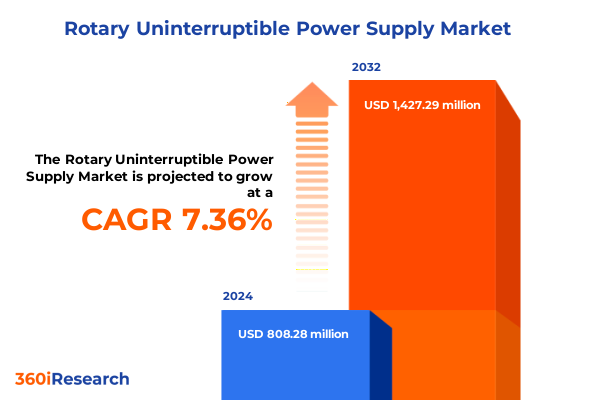The Rotary Uninterruptible Power Supply Market size was estimated at USD 11.24 billion in 2024 and expected to reach USD 12.02 billion in 2025, at a CAGR of 7.73% to reach USD 20.41 billion by 2032.

Charting the Future of Mission-Critical Operations through Rotary Uninterruptible Power Supply Solutions to Ensure Uninterrupted Performance
Rotary uninterruptible power supply systems harness mechanical energy stored in high-speed flywheels coupled with synchronous generators to deliver instantaneous backup power during grid disturbances. Unlike static battery-based solutions, these rotating machines rely on kinetic inertia to bridge the gap between a power loss event and generator startup, ensuring that critical loads remain energized without interruption. This mechanical approach provides high reliability, long lifecycle performance, and rapid ride-through capabilities, making rotary UPS solutions a cornerstone for mission-critical applications.
As organizations face increasingly complex operational demands, the need for seamless power continuity has never been more pronounced. Data centers, healthcare facilities, and manufacturing plants operate around the clock and require robust protection against voltage sags, frequency fluctuations, and extended outages. In this context, rotary UPS offerings deliver both low total cost of ownership and superior operational resilience. By combining proven mechanical design with advanced monitoring controls, these systems ensure uninterrupted performance in environments where even a fraction of a second of downtime can have far-reaching consequences.
Adapting to Rapid Technological Advances and Sustainability Demands that Are Redefining the Role of Rotary Uninterruptible Power Systems Worldwide
The landscape for uninterruptible power solutions is shifting rapidly as digital transformation and sustainability agendas reshape operational requirements. Edge computing architectures are emerging to process data closer to the source, driving demand for localized power continuity and protection. Concurrently, hyperscale data centers continue to push for higher density power modules that integrate seamlessly with renewable energy sources and microgrid infrastructures. These technological advances underscore the growing importance of rotary UPS systems that can adapt to variable load profiles while maintaining efficiency.
At the same time, regulatory frameworks around energy efficiency and carbon emissions have become more stringent, prompting manufacturers to innovate in areas such as advanced power electronics and intelligent controls. Rotary UPS solutions now feature predictive maintenance algorithms and remote diagnostics, enabling proactive management of equipment health. This convergence of digital capabilities and environmental accountability is redefining how organizations select and deploy uninterrupted power solutions, ultimately driving a new era of resilient and sustainable infrastructure.
Evaluating the Far-Reaching Consequences of New Tariff Measures on Rotary UPS Supply Chains and Cost Structures in the United States Market
In 2025, a series of U.S. tariff measures targeting critical components and raw materials have exerted pronounced effects on the rotary UPS supply chain. Steel and aluminum levies under Section 232 have driven up the cost base for heavy mechanical assemblies, while expanded Section 301 tariffs on imports from certain regions have affected bearings and precision power electronics used in high-speed flywheels. These added duties have translated into higher procurement expenses and extended lead times for manufacturers reliant on global sourcing.
As a result, solution providers have accelerated efforts to diversify their supply chains by near-shoring production and qualifying alternative vendors. Inventory management strategies have evolved to include buffer stocks of long-lead items, while contractual terms now account for tariff volatility. End users, in turn, are negotiating service-level agreements that mitigate the risk of material shortages and price fluctuations. Collectively, these adaptations underscore the critical need for supply chain resilience in an environment shaped by evolving trade policies.
Unlocking Critical Insights through Detailed Analysis of Phase, Mounting, and Industry End User Dynamics Shaping the Rotary UPS Market
Phase type segmentation encompasses single phase and three phase configurations, each tailored to distinct application requirements. Single phase solutions excel in supporting point-of-use systems and small-scale installations where compact footprint and simplicity are essential. Conversely, three phase units cater to large data centers and industrial facilities that demand balanced load distribution, higher power density, and optimized efficiency under heavy-duty operations.
Mounting type considerations further influence system selection, with rack installations offering streamlined integration in telecommunications closets, tower designs providing standalone flexibility in mechanical rooms, and wall mount options delivering space-saving deployment in constrained environments. End user industries each impose unique performance mandates: healthcare institutions require unwavering power for life-critical equipment, IT and telecom operators prioritize continuous connectivity and data integrity, and manufacturing sites depend on steady power to maintain production line throughput and safeguard sensitive machinery. By aligning technical characteristics with end user demands, stakeholders can ensure that rotary UPS solutions deliver both reliability and operational agility.
This comprehensive research report categorizes the Rotary Uninterruptible Power Supply market into clearly defined segments, providing a detailed analysis of emerging trends and precise revenue forecasts to support strategic decision-making.
- Phase Type
- Mounting Type
- Technology
- End User Industry
- Customer Size
Delineating Regional Variations and Strategic Opportunities across the Americas, Europe Middle East & Africa, and Asia-Pacific Rotary UPS Markets
Regional market characteristics exhibit pronounced variation due to local regulatory regimes, infrastructure maturity, and environmental conditions. In the Americas, stringent uptime requirements and substantial investments in digital infrastructure have propelled the adoption of high-capacity rotary UPS systems. Modernization initiatives across healthcare campuses and advanced manufacturing facilities continue to reinforce the region’s appetite for reliable power continuity.
Within Europe, the Middle East & Africa, regulatory emphasis on energy efficiency and grid stability has driven interest in flywheel and hybrid power solutions that integrate with renewable energy assets. This region’s focus on decarbonization and microgrid deployments underscores the versatility of rotary UPS offerings. Meanwhile, Asia-Pacific’s rapid industrial growth, coupled with government incentives for critical infrastructure resilience, has created significant demand in telecommunications, finance, and public services. Tailoring systems to withstand diverse climate conditions-ranging from extreme heat in desert locales to high humidity in coastal zones-has become an imperative for solution providers targeting these regional markets.
This comprehensive research report examines key regions that drive the evolution of the Rotary Uninterruptible Power Supply market, offering deep insights into regional trends, growth factors, and industry developments that are influencing market performance.
- Americas
- Europe, Middle East & Africa
- Asia-Pacific
Profiling Leading Industry Stakeholders and Their Strategic Initiatives Driving Innovation in Rotary Uninterruptible Power Supply Solutions
Leading technology firms including ABB, Siemens, Vertiv, GE Renewable Energy, and Mitsubishi Electric have each invested in enhancing their rotary UPS portfolios through the incorporation of advanced flywheel bearings and high-efficiency motor designs. These companies are prioritizing digital transformation initiatives, embedding real-time monitoring and analytics platforms that enable customers to proactively address potential faults and streamline maintenance planning.
Strategic collaborations between established power electronics vendors and emerging energy storage innovators have given rise to hybrid architectures that combine kinetic energy storage with scalable battery modules. By leveraging these joint efforts, the industry has accelerated the deployment of modular, service-friendly solutions that meet evolving customer expectations for sustainability and uptime. Additionally, global service networks and extended warranty programs have emerged as critical differentiators as organizations seek comprehensive support across diverse geographical footprints.
This comprehensive research report delivers an in-depth overview of the principal market players in the Rotary Uninterruptible Power Supply market, evaluating their market share, strategic initiatives, and competitive positioning to illuminate the factors shaping the competitive landscape.
- Ampacet Corporation
- Clariant AG
- Cabot Corporation
- Avient Corporation
- Plastiblends India Limited
- Borealis AG
- Ravago Group SA
- Adeka Corporation
- DIC Corporation
- Birla Carbon Private Limited
- LyondellBasell Industries Holdings B.V.
- Plastika Kritis S.A.
- Hubron International Ltd
- Tosaf Group Ltd
- RTP Company
Implementing Actionable Strategies to Enhance Competitive Advantage for Manufacturers and Service Providers in the Rotary UPS Domain
To maintain a competitive edge, manufacturers and service providers should embrace modular system designs that facilitate capacity upgrades and component replacements without disrupting operations. Integrating open communication protocols with building management and cloud platforms will enhance visibility into system performance and simplify remote diagnostics, thereby reducing onsite intervention requirements.
Building resilient supply chains through local production partnerships and dual-sourcing strategies can mitigate the impact of future tariff fluctuations. Equally important is the deployment of predictive maintenance systems that employ machine learning algorithms to forecast mechanical wear and optimize service schedules. By aligning product roadmaps with tightening energy efficiency and emissions standards, industry leaders can position themselves to capture emerging opportunities in both retrofit and greenfield projects.
Outlining a Rigorous, Multi-Methodological Approach to Ensure Data Integrity and Insight Validity in Rotary UPS Market Research
The research methodology combined a rigorous review of technical literature, relevant industry standards, and vetted white papers to establish a foundational understanding of rotary UPS performance parameters. Primary data collection involved structured interviews with senior engineers, maintenance specialists, and end user representatives across healthcare, telecommunications, and manufacturing segments.
Findings were validated through data triangulation that incorporated public procurement notices, vendor specification sheets, and independent case studies. Qualitative insights were derived via thematic coding to surface common operational challenges, while stakeholder benchmarking against peer deployments ensured that the analysis reflects prevailing best practices and technical benchmarks within the rotary uninterruptible power domain.
This section provides a structured overview of the report, outlining key chapters and topics covered for easy reference in our Rotary Uninterruptible Power Supply market comprehensive research report.
- Preface
- Research Methodology
- Executive Summary
- Market Overview
- Market Insights
- Cumulative Impact of United States Tariffs 2025
- Cumulative Impact of Artificial Intelligence 2025
- Rotary Uninterruptible Power Supply Market, by Phase Type
- Rotary Uninterruptible Power Supply Market, by Mounting Type
- Rotary Uninterruptible Power Supply Market, by Technology
- Rotary Uninterruptible Power Supply Market, by End User Industry
- Rotary Uninterruptible Power Supply Market, by Customer Size
- Rotary Uninterruptible Power Supply Market, by Region
- Rotary Uninterruptible Power Supply Market, by Group
- Rotary Uninterruptible Power Supply Market, by Country
- Competitive Landscape
- List of Figures [Total: 30]
- List of Tables [Total: 417 ]
Concluding Insights on the Enduring Relevance and Strategic Imperatives for Rotary UPS Adoption in Evolving Operational Environments
Rotary uninterruptible power systems continue to demonstrate their strategic value by combining mechanical robustness with rapid ride-through performance, making them indispensable in scenarios where power continuity is non-negotiable. Their kinetic energy storage approach not only delivers immediate backup during grid interruptions but also contributes to reduced maintenance overhead and extended equipment lifespans.
As organizations navigate the complexities of digital transformation, sustainability targets, and evolving regulatory requirements, the adoption of rotary UPS technology remains a critical lever for ensuring operational resilience. By prioritizing digital integration, modular design, and proactive supply chain management, stakeholders can harness the full potential of these solutions to safeguard critical infrastructure and support future growth imperatives.
Take the Next Step to Secure Operational Resilience with Expert Guidance from Ketan Rohom on Comprehensive Rotary UPS Market Intelligence
To explore how these insights apply to your organization’s unique requirements and to gain access to the full market research report, reach out to Ketan Rohom, Associate Director of Sales & Marketing at our firm. His team can provide personalized guidance, detailed data tables, and executive briefings that will equip you to make informed decisions and secure your operational resilience with the latest rotary UPS intelligence.

- How big is the Rotary Uninterruptible Power Supply Market?
- What is the Rotary Uninterruptible Power Supply Market growth?
- When do I get the report?
- In what format does this report get delivered to me?
- How long has 360iResearch been around?
- What if I have a question about your reports?
- Can I share this report with my team?
- Can I use your research in my presentation?




